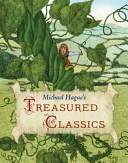This book offers students an introduction to the rich and diverse foods found around the world.
Intermediate (ages 9-14)
Material appropriate for intermediate age groups
The Food of Italy

This book explores the culture, traditions, and festivals of Italy through its food.
Magic Wool

Activities with unspun sheep’s wool, also known as magic wool, offer a wide range of creative possibilities for both children and adults. In this book Dagmar Schmidt and Freya Jaffke combine their talents and experience, and show how to create beautiful pictures, as well as table-top scenes featuring figures and animals. They explain the process of carding and dyeing unspun wool to make ‘magic wool’. They focus on making pictures with wool, including scenes from several well-known fairy tales and festivals, before showing how to make simple dolls and animals, building up to an entire nativity scene. Detailed instructions, diagrams and colour photographs are provided throughout.
Treasured Classics

Acclaimed illustrator Michael Hague brings his hallmark artistry to 15 classic stories that have delighted children for generations. From Cinderella and Sleeping Beauty to The Gingerbread Man and The Three Billy Goats Gruff, each story is lush with detail and loaded with magic. A wealth of fable and fantasy, truly to be treasured.
Half Spoon Of Rice

Nine-year-old Nat and his family are forced from their home on April 17, 1975, marched for many days, separated from each other, and forced to work in the rice fields, where Nat concentrates on survival. Includes historical notes and photographs.
See the review at WOW Review, Volume 4, Issue 2
A Stranger at Home

The powerful memoir of an Inuvialuit girl searching for her true self when she returns from residential school. Traveling to be reunited with her family in the Arctic, 10-year-old Margaret Pokiak can hardly contain her excitement. It’s been two years since her parents delivered her to the school run by the dark-cloakednuns and brothers. Coming ashore, Margaret spots her family, but her mother barely recognizes her, screaming, “Not my girl.” Margaret realizes she is now marked as an outsider. And Margaret is an outsider: she has forgotten the language and stories of her people, and she can’t even stomach the food her mother prepares. However, Margaret gradually relearns her language and her family’s way of living. Along the way, she discovers how important it is to remain true to the ways of her people — and to herself. Highlighted by archival photos and striking artwork, this first-person account of a young girl’s struggle to find her place will inspire young readers to ask what it means to belong.
See the review at WOW Review, Volume 4, Issue 2
This book has been included in WOW’s Language and Learning: Children’s and Young Adult Fiction Booklist. For our current list, visit our Booklist page under Resources in the green navigation bar.
Dan Eldon: Safari as a Way of Life

Photojournalist Dan Eldon left behind much more than the astonishing illustrated journals that would form The Journey is the Destination when he lost his life at age twenty-two while on assignment in Somalia. He also bequeathed a life story that has inspired students, teachers, artists, and creative activists—as well as a forthcoming film, an apparel line, and the Spring 2011 collection from Tom’s Shoes. Raised in Kenya, Dan grew up with a unique outlook on life. Through adventurous safaris and benevolent crusades around the world, he crafted a philosophy of curiosity, creativity, and charity. This unique visual biography showcases previously unpublished artwork from Dan’s acclaimed journals, letters, and snapshots that takes readers on a journey through Dan’s life and beyond, exploring the impact made by this remarkable artist on everyone who has encountered his story.
The Aztecs

The Aztecs built an advanced and dazzling empire that stretched across a large part of Mesoamerica. The Chuampa “floating gardens” system of farming is perhaps their most remarkable accomplishment. Other discoveries and inventions related to transportation, agriculture, architecture, science, and technology, enriched their culture and provide a way for us to experience parallels between ancient times and the world we know today.
The Chinese

This book focuses on the discoveries and inventions of the ancient Chinese civilization in the areas of transportation, agriculture, architecture, science, and technology.
The Project

It begins with a book, the most boring book in the world, a book so boring no one could ever read it—the perfect place to hide a dangerous secret.
When best friends Luke and Tommy volunteer to help move books from their library’s basement to higher ground during a quick rising flood, they discover the only surviving copy of the most boring book in the world: Leonardo’s River, lost for over 100 years. The book is connected to Leonardo da Vinci and is worth millions, so they return that night to steal it. After they steal it from the library, dark forces are soon on their tail. Luke and Tommy must unlock the mystery first, but with their pursuers closing in, the clock is ticking down to the final hour.
